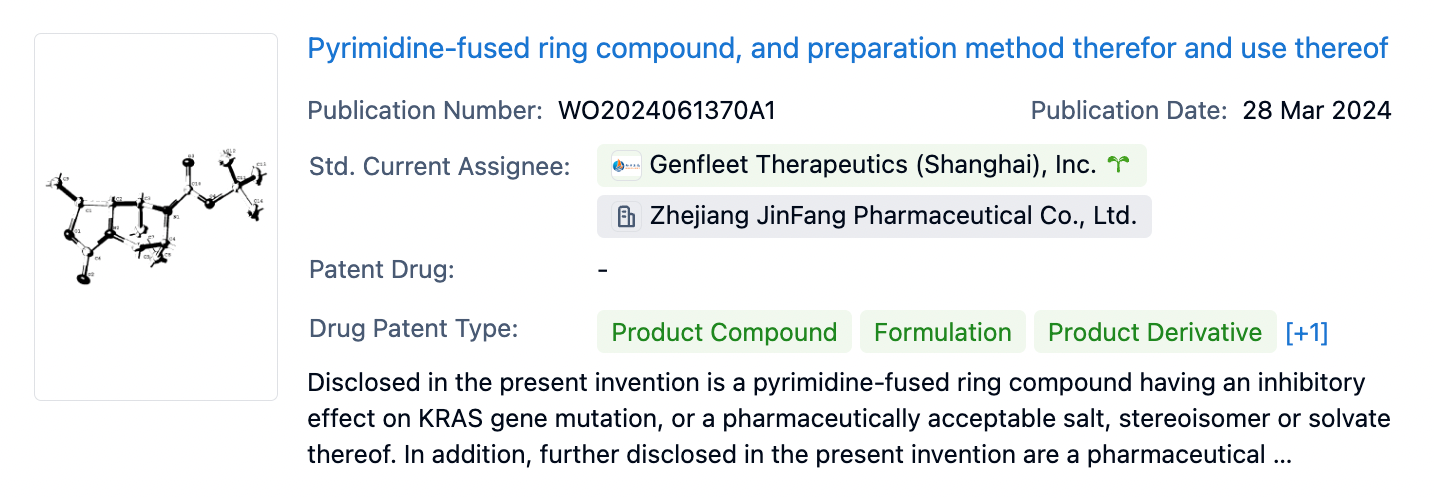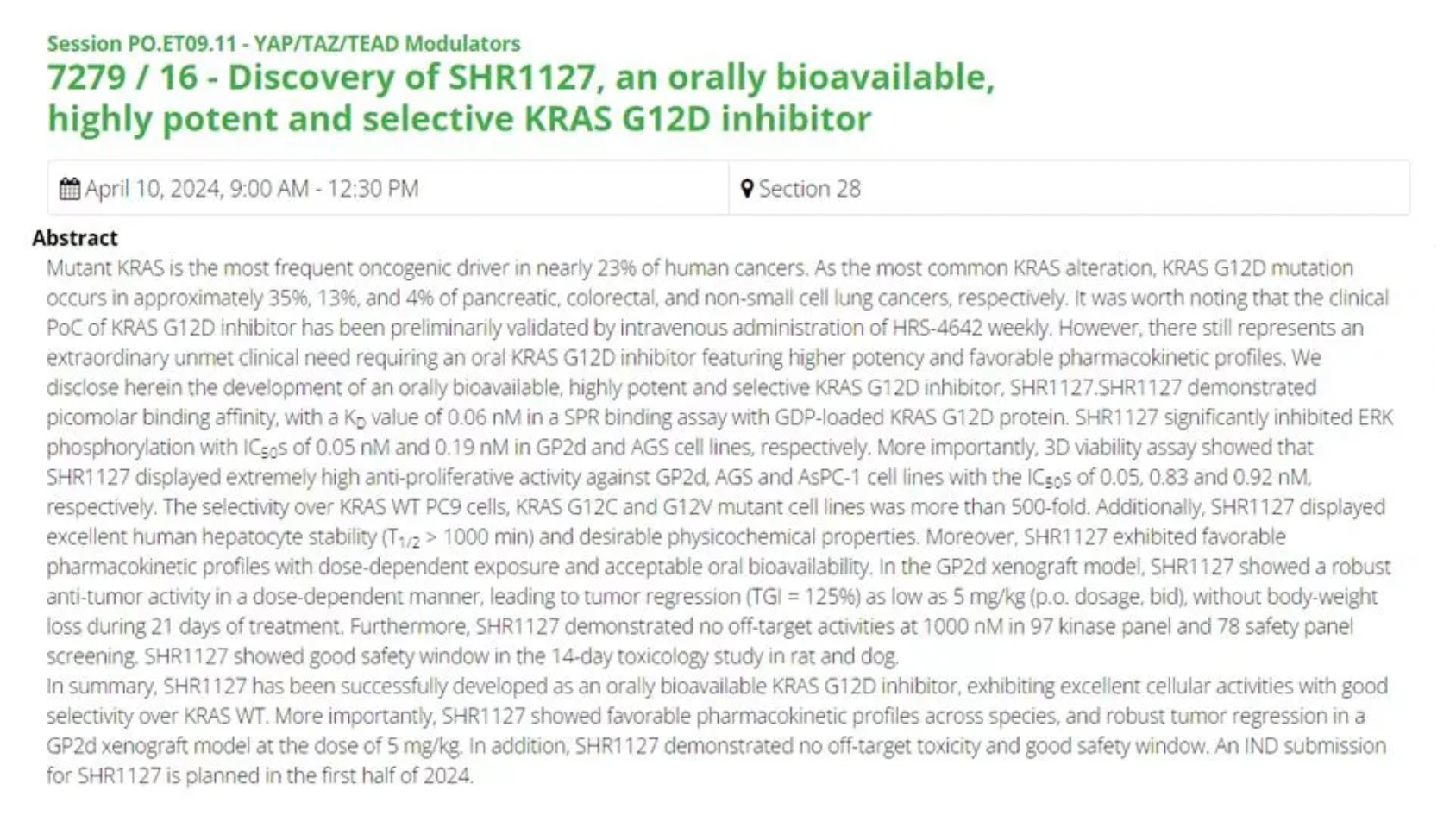Genfleet Therapeutics Announces the Potential Molecular Structure of Its Oral KRAS G12D Inhibitor through the Publication of its Patent
On March 28th, Genfleet Therapeutics publicly announced a patent for an oral KRAS G12D inhibitor, with the patent number WO2024061370A1, and the patent application date being September 25th, 2023. The earliest priority date is September 23rd, 2022.
In 2023, Verastem acquired three innovative RAS pathway-targeted therapies from Genfleet Therapeutics, including GFH375, for development outside of the Greater China region, with a total transaction value exceeding 625 million USD. GFH375 is an oral KRAS G12D inhibitor. According to the official website of China's Center for Drug Evaluation (CDE), the application for clinical trial of GFH375 tablets, a Category 1 chemical new drug by Genfleet Therapeutics, was accepted on April 3rd, 2024. According to reports from Genfleet Therapeutics, the drug is a KRAS G12D inhibitor. Based on the structure disclosed in the recently published patent, the structure of GFH375 is believed to be included in patent WO2024061370A1.

Genfleet Therapeutics' patent spans 387 pages and includes 149 implementation examples. It primarily secures the structure of a class of tetracyclic compounds; Genfleet's current KRAS G12C molecule is also in Phase III clinical trials. Although AMG510 faces the risk of withdrawal from the market, KRAS G12C inhibitors from companies like MIRATI and LILY have demonstrated sufficient safety and efficacy. The G12D subtype, other subtypes, and Pan-KRAS are all hotspots for research and development.
In addition to the 149 examples, the Genfleet patent also features dozens of pages of molecular structures. Noteworthy molecules include Z131-1, Z140-1, Z1054, and Z1084. At a dosing level of 10 mpk, Z131-1 and Z140-1 did not perform well, with exposure levels only in the 40 and bioavailability of merely 0.9-2.33%. However, at a 30 mpk dose, the exposure for Z1084 and Z1054 could reach 2440 and 3252, respectively, with bioavailabilities of 20.7% and 29.4%. The only difference between Z1084 and Z1054 is a deuterated methyl group, which significantly increases the exposure and bioavailability to nearly 30%. Notably, the inclusion of a vinylidene difluoride group in the molecule is a common strategy to circumvent existing patents; it's uncertain how molecules containing such a fragment will perform in clinical settings.
Jiangsu Hengrui Pharmaceuticals is also a significant player in the field of KRAS G12D inhibitors. Having missed out on the substantial opportunity with KRAS G12C, Hengrui has been rapidly catching up in the KRAS G12D domain. Not only has the company's first injectable drug entered clinical trials, but its oral KRAS G12D inhibitor also shows promising data. Hengrui is set to reveal a poster at the upcoming AACR conference, where the key molecule, SHR1127, demonstrates strong binding affinity with pimasertib. In SPR binding analysis, SHR1127 exhibits a Kd value of 0.06nM when bound to GDP-loaded KRASG12D protein. In the GP2 and AGS cell lines, SHR1127 significantly inhibits ERK phosphorylation with IC50 values of 0.05 nM and 0.19nM, respectively. More importantly, 3D activity analysis indicates that SHR1127 displays extremely high anti-proliferative activity against GP2d, AGS, and AsPC-1 cell lines, with IC50 values of 0.05, 0.83, and 0.92nM, respectively. The compound exhibits selectivity greater than 500-fold against the KRASWT PC9 cell and KRASG12C and G12V mutant cell lines.

Furthermore, SHR1127 demonstrated excellent human hepatocyte stability (with a half-life greater than 1000 minutes) and ideal physicochemical properties. SHR1127 exhibited favorable pharmacokinetic profiles with dose-dependent exposure and acceptable oral bioavailability. In the GP2d xenograft model, SHR1127 showed potent antitumor activity in a dose-dependent manner, leading to tumor regression (TGI=125%) at doses as low as 5 mg/kg (orally, twice daily), with no loss of body weight over a 21-day treatment period. In addition, the kinase profile of SHR1127 was exceptionally clean. SHR1127 presented a good safety margin in 14-day toxicology studies conducted in rats and dogs.
While data vary among companies, this is currently the most active oral KRAS G12D inhibitor seen by the author, and it also has the lowest efficacious dose in mice among oral KRAS G12D inhibitors. Hengrui plans to submit an IND application for SHR1127 in the first half of 2024.
In the Synapse database, a search was conducted for patents on Hengrui's oral KRAS G12D inhibitor, resulting in the retrieval of patent WO2024022444. The filing date of the patent is July 27, 2023, with the earliest priority date being July 27, 2022, which predates that of Genfleet Therapeutics by two months. The key molecule, like that of Genfleet, also features a tetracyclic structure and possesses a difluoroalkene moiety.
The Hengrui patent disclosed only 45 examples, yet the actual synthesized molecules are clearly more numerous. Additionally, the patent includes several dozen pages illustrating the novelty of the molecules in potentially infringing other companies' patents. The pivotal molecule 39 achieved a Cmax of approximately 600 at a dosing level of 40 mpk, an exposure level of 7212, and a half-life spanning 10 hours.
On March 13th, it was officially announced on the CDE (Center for Drug Evaluation) website that Shanghai Allist Pharmaceuticals' Category 1 innovative drug, the liposomal injection AST2169, received approval for clinical trials. AST2169 is also an inhibitor of KRASG12D. USYNOVA's small molecule candidate drug UA022 was transferred to AstraZeneca on November 20, 2023, with an upfront payment of 24 million USD and a total deal value of 419 million USD; BeiGene has also made arrangements in this field, with relevant patents including WO2022148421, WO2022148422, and WO2024008179. In addition, enterprises such as Jiakesi, Nanjing Mingde, Betta Pharmaceuticals, and Zhejiang Hisun Pharmaceutical have also made strategic deployments in this area.
KRAS G12D is the most common KRAS mutation, and it is also the most prevalent subtype of KRAS mutations in pancreatic cancer and colorectal cancer, with limited treatment options available. Currently, there are no KRASG12D inhibitors on the market, and there is hope that oral KRAS G12D inhibitors will show more promising data in clinical trials, as well as address patient compliance issues.




